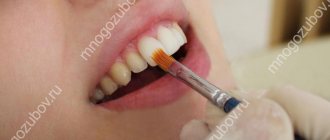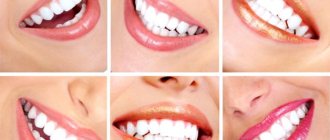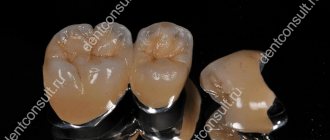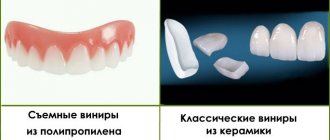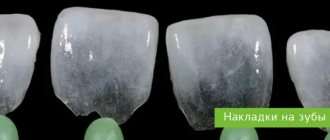Do you dream of a flawless Hollywood smile? Do you want your teeth to be perfectly straight and white, like those of Insta stars and celebrities? This is possible, and even for a very reasonable budget. At the 32 Dent clinic, you can completely restore your teeth using high-quality and modern veneers. Just a couple of visits to the dentist’s office - and you will get the same result that will pleasantly impress you and those around you!
Veneers are thin overlays 0.2 - 0.7 mm thick, which are fixed to the outer surface of their teeth using a special adhesive. They can also be called microprostheses, plates, prostheses, but the essence does not change. This is the most effective method in a couple of visits to the dentist to transform unaesthetic teeth into absolute perfection in color, shape and transparency!
This is interesting! The very first dental veneers appeared at the beginning of the 20th century in the USA, and they were intended for Hollywood stars (hence the phrase “Hollywood smile”). Initially, these were unnaturally white and rough in structure ceramic plates of impressive thickness, which made their teeth larger - it was visually noticeable that there were dentures in the mouth.
Modern designs are more advanced, but at the same time they look natural and aesthetically pleasing. You can easily verify this by looking at examples of the work of doctors at the 32 Dent clinic. The result will impress you!
Who is recommended for veneers and who is not?
In principle, any patient can get dental veneers if they have the funds and the desire. Most often, veneers are installed on teeth for the following reasons:
- not satisfied with the natural color of your teeth;
- there are stains or microcracks on the tooth surface that you want to disguise;
- if there are three (small distances a few millimeters wide);
- in cases where teeth are prone to increased wear at the edges;
- if there are minor orthodontic defects, for example, the tooth is slightly rotated, or mild crowding is diagnosed.
Note!
Even the most modern whitening technologies are not able to give tooth enamel such impeccable whiteness as microprostheses. That is why more and more patients are inclined to install veneers and make their dream of incredibly beautiful teeth come true! Like any restoration procedure, the installation of veneers has its contraindications. It will not be possible to install dental microprostheses if:
- the patient suffers from bruxism - otherwise, microprostheses will constantly break;
- when your teeth are loose and in poor condition, prosthetics will help here (possibly together with implantation);
- if the enamel thickness is insufficient or it is destroyed, then the microprosthesis will not hold;
- the teeth are naturally underdeveloped, too small - the structures simply will not be fixed on the surface;
- there are acute diseases of the ENT organs, problems with the heart and blood vessels, tumors, etc.
Relative contraindications are problems with bite and caries - these issues can be treated, and only after that you can work on the aesthetics of your smile.
Note! If a tooth has been restored by more than 60%, it has a large filling, and it is not advisable to install onlays on it. This can lead to subsequent destruction of the crown, and the patient will already spend a considerable amount on the installation of dental microprostheses. Perhaps in this case, prosthetics at the 32 Dent clinic will help.
How veneers differ from crowns and composite restorations
Veneers, crowns and composite restorations solve various dental problems:
- Veneers are designed to improve the appearance of teeth. With their help, you can get straight teeth in a few days, sometimes in one visit to an orthopedic dentist, and hide visual defects - unsightly color, darkened fillings, crookedness.
- The purpose of a crown is to protect the tooth from destruction. Typically, crowns are placed on teeth after root canal treatment and nerve removal. After opening the cavity due to pulpitis, periodontitis or caries, the tooth becomes more vulnerable and is destroyed faster. To preserve it, the surface is completely covered with a crown.
- Composite restoration is the restoration of the shape of a partially destroyed tooth using filling materials. For example, when part of the crown broke off or the doctor had to remove enamel and dentin in a significant area due to severe caries damage.
Let’s summarize the differences: with the help of veneers, visual defects are eliminated, crowns are necessary to protect teeth from destruction, and composite restoration is used to restore damaged teeth.
What you need to be prepared for when deciding to install veneers on your teeth
Unfortunately, patients are not always aware of all the points associated with these structures.
- The crown must first be ground. In most cases, when installing veneers, the enamel must be prepared (remove a microscopic layer) - otherwise, the overlay will stick out and provoke an unattractive effect. But in this case, you can choose an alternative - ultra-thin lumineers, which are attached to the enamel without pre-turning, but at a price - they are much more expensive than conventional onlays.
- Not for life! When deciding one day to put veneers on your teeth, be prepared that in a few years you will have to replace them with new ones. Even the best pads won't last a lifetime. If we are talking about composite veneers, they will have to be replaced after 5 – 7 years.
- Beware of caries! Unfortunately, even the best and well-installed structures do not guarantee that caries will not develop under them. Therefore, experts recommend that patients with veneers monitor their oral hygiene even more carefully and undergo regular preventive examinations in the clinic.
- Pleasure is not cheap. This is not only about the beauty of teeth, but also about the need to invest periodically. So, for example, if one pad breaks or comes off, it will have to be replaced with a new one, which also costs money. However, by investing in your health and beauty, you get much more!
How to restore teeth: with crowns or veneers
If the metal crown is still intact, but is unaesthetic, then some patients ask the question: is it possible to simply cover it with veneer?
As an orthopedist with many years of experience, I answer: no. Dramatic changes are required. Metal
– an irrational way to restore front teeth. It is better today to immediately make beautiful and durable dentures from ceramics. You can replace the old metal version with a metal-free one, created using the unique Cerec technology. The new tooth will most likely be more beautiful than your own, natural ones. If you are not satisfied with the appearance of the neighboring teeth - they have darkened, or have a slight curvature, uneven interdental distances, then I recommend installing veneers on them (this is inexpensive, pays off in terms of image and long service life) in Moscow in our clinic.
Nuance:
Veneers straighten teeth only visually. These are thin petal linings on the front part of the tooth with a cutting edge. Serious bite defects can only be corrected with braces or mouth guards. And overlays mask imperfections (curvature, chips, small cracks in the enamel or stains). The structure of the teeth and their location do not change.
The cost of ceramic veneers for front teeth in Moscow in my clinic is 50,000 rubles per tooth. The total price can be calculated by submitting a request to the site’s online calculator. And (secretly) you can get a personal discount.
What types of veneers are there? Which is better to choose?
Conventionally, three groups of restoration structures for teeth can be distinguished, if we take into account the specifics of their installation:
- Direct – plates that are installed directly in the dentist’s chair. The specialist first grinds the tooth, after which he applies the composite material layer by layer - by analogy with artistic restoration. As a result, it is possible to obtain a beautiful “new” tooth in shape, color and transparency. The main advantage of direct overlays is their price. The main disadvantage of direct structures is that over time, the composite material still darkens, turns yellow, and the aesthetics are no longer the same.
- Indirect - onlays that are made in advance using impressions taken from the patient’s ground teeth. After the plates are ready, they are tried on the prepared teeth, and then they are fixed using an adhesive composition. While the veneers are being produced in a laboratory, special temporary structures are placed on the patient’s teeth (similar to temporary dentures). The main advantage of indirect solutions is that they are more durable and do not change their color and transparency throughout their entire service life. The main disadvantage of indirect overlays is their high price compared to composite plates.
- Semi-direct – a combination of the two technologies listed above. First, impressions of the patient’s teeth are taken, and new onlays from composite material are made in the dental laboratory. The main advantage of semi-direct veneers is that their fixation to the teeth is considered more reliable. The main disadvantage of semi-direct options is that composite linings still last no more than five years; over time, they will have to be replaced with new ones.
As you can already understand from our examples of clinical cases, dentists distinguish two categories based on the material of manufacture:
- Composite – dental onlays made of filling composite. In some cases, they can be installed without first grinding down your tooth. For example, when there are microscopic cracks in the enamel, or the patient is not satisfied with the shade of the tooth enamel. A thin layer of composite material will mask these moments and allow you to achieve ideal whiteness of your teeth. There will be no visible transitions from the composite composition to the native tissues of the tooth enamel.
- Ceramic – dental plates made from dental ceramics. More advanced solutions in terms of creating ideal tooth shapes. They will help to align and achieve ideal anatomical proportions of teeth, since the structure of the material is as close as possible to the characteristics of natural enamel. At the same time, the price of ceramic analogues is three or even five times higher than the price of classic composite overlays.
Which veneers are best to choose? The question is strictly individual. To answer this, the dentist must:
- assess the condition of the patient’s teeth;
- see the condition of the jaw and exclude serious orthodontic abnormalities;
- find out the goals pursued by the patient who wants to install linings from a particular material;
- roughly be aware of the allocated budget for smile restoration.
It is important! In case of severe curvature of the teeth or pathologies of the jaw, guilt is undesirable. But the patient can always straighten the teeth first and then install veneers to get the picture of their dreams.
As practice shows, ceramic structures are still more preferable. Firstly, this is quality that will prove itself within 20 years. Secondly, it is reliable; teeth will not darken from coffee or cigarettes in a year. Thirdly, if you calculate the budget for installing composite systems every 5 years, then installing ceramic veneers is more profitable from a financial point of view.
Among the most common ceramic veneers, we note 4 directions:
- Zirconium dioxide dental veneers – the main part is made of zirconium alloy, and the top is coated with dental porcelain. They are considered one of the most reliable and durable, but in terms of their tint range and transparency they may be inferior to glass ceramic linings;
- Made from glass ceramics – so-called metal-free plates, which are made in a dental laboratory from pressed glass ceramics. The most popular plates you may have heard of are E Max CAD and E Max Press;
- Porcelain dental veneers are the “gold standard” of designs that combine optimal price and quality. Dental porcelain is the same ceramics, but with characteristics closer to natural enamel;
- Ultra-thin or lumineers are dental onlays approximately 0.02 millimeters thick. They are considered the thinnest, their installation does not require preliminary grinding of the enamel, but their cost is several times more expensive than classic porcelain ones.
Removable veneers
Modern manufacturers offer a large selection of products for whitening teeth, keeping them clean, and also for restoring a smile without the intervention of specialists. In online stores you can purchase silicone jaws that imitate real, healthy teeth. However, they can only be used as a toy or souvenir, since serious discomfort will occur when worn.
The reason is that real removable veneers are made from an impression, as a result of which they are very comfortable and are practically not felt even with active articulation. Mass produced pads may not fit properly and may fall out or become dislodged. Cheap analogs may be made from low quality material, which can cause an allergic reaction in a sensitive person.
Why do they make a cast? The thing is that all people's teeth have different shapes, heights and widths, they are located at different distances from each other. Only based on individual parameters it is possible to create truly comfortable, strong and durable veneers. Agree, even the most beautiful teeth will be unpleasant to use if they prevent the jaw from closing freely.
Installation of veneers: features, important nuances that the patient should know better about
The indirect method involves 3 steps:
- Preparation. First, the tooth enamel is ground down a few tenths of a millimeter - a thin layer of enamel is removed. Then the dentist makes impressions of the patient’s also prepared teeth, after which he covers them with special protective caps - for the period of time while the veneers are produced in the laboratory;
- Visualization. Computer model with “before” and “after” effect. In a 3D program, the dentist creates a virtual model of teeth and clearly demonstrates how it was and how it will be after. The picture is usually impressive and motivating;
- Installation of veneers - your new perfect smile is ready! The dentist fixes the onlays on the tooth enamel, and the patient evaluates the final result.
Installation of microprostheses using the direct method also involves 3 steps:
- Preparation. The dentist removes a small layer of tooth enamel for the patient and prepares the teeth for further restoration;
- Installation of composite structures. Layer by layer, the dentist distributes the composition over the surface of the enamel, while each of them is illuminated with a lamp to “seal”;
- Polishing and finishing to perfection. The enamel surface is carefully polished, the shape of each tooth is brought to perfection.
How are veneers different from braces?
Both veneers and braces are used to eliminate defects and make your smile beautiful. But they solve this problem in different ways:
- Veneers are permanent coverings that are attached to the surface of the tooth and remain there forever (unless there is a need to replace them). They create the necessary visual effect.
- Braces are a removable orthodontic structure whose task is to physiologically change the position of teeth in the dentition and correct the bite. Once the goal is achieved, the braces are removed.
Not in all cases, veneers are enough to eliminate the defect. For example, if a patient’s teeth are severely crooked or have an incorrect bite, it is not recommended to install veneers. In order to create the effect of an even row with their help, the teeth will have to be sharpened greatly, and this will significantly speed up their destruction. In case of such defects, it is advisable to straighten the teeth using braces.
Price question: how much does it cost to install veneers?
As we already said, dental veneers are not cheap, but they are worth it!
Approximate cost of microprostheses:
- Composite ones are the most budget-friendly. The cost of one unit is approximately 7 thousand rubles;
- Ceramic microprostheses, which are manufactured in a dental laboratory, cost approximately 20 thousand rubles per unit;
- Ceramic dental veneers made at the 32 Dent clinic will cost the patient about 15 thousand rubles per unit;
- Lumineers are the most expensive - from 50 thousand rubles per unit.
How can you save on installing veneers?
There are two ways to go. Place veneers on individual teeth for the patient. For example, for 10 units of the upper jaw - provided that your teeth are in good condition. You can whiten the enamel of your teeth, but the result will not always be perfect.
There is also a solution to take advantage of the favorable conditions of clinics. Thus, 32 Dent dentistry regularly holds promotions and special offers for the installation of veneers. There are opportunities to install dental microprostheses at a discount of 15% to 50%. The quality of work is at the highest level, as are the guarantees.
Content:
- Main differences
- Types of veneers
- Dental crowns
- Veneers or crowns - how to make a choice 4.1. When is it better to install veneers 4.2. When you can't do without crowns
- Can veneers be glued to crowns?
The wording of the question “Veneers or crowns?” not entirely true. These designs are used in different clinical situations, although they can conditionally be classified as one area in dentistry. Meanwhile, in medical practice, sometimes there are cases when the patient needs to choose what to install - a thin overlay or a full-fledged prosthesis that replaces the entire unit.
Hit list of questions and answers about veneers
Do veneers ruin your teeth?
Answer: teeth are spoiled by carious lesions, neglect of hygiene rules, lack of regular visits to the dentist, poor nutrition, and bad habits. Veneers, made of first-class material and installed by a professional dentist, on the contrary, protect the enamel from harmful external influences.
Is it painful to install?
Answer: no, it doesn't hurt. The procedure is performed under local anesthesia in a comfortable environment. It is important! There is no need to remove dental nerves during installation.
How long will it take to install?
Answer: on average, from 5 to 14 days or 2 to 3 visits to the dentist’s office.
Dental clinic "32 Dent" specializes in the installation of dental veneers on a turnkey basis. Both budget-class microprostheses and premium solutions are available, including patented American lumineers. Schedule an initial consultation with your doctor to choose the best path to restoring your smile with veneers. The smile will be beautiful and at the same time natural. Take action!
Advantages of ceramic veneers over composite ones
Unlike composite ones, the advantages of ceramic onlays are obvious to any specialist. And here's why: even the most expensive composite is actually plastic; it quickly loses its shine, darkens and delaminates over time. This means that composite veneers are less durable and aesthetically pleasing. Ceramic veneers, on the contrary, cannot be stained, do not change their shape, retain their relief and have the shine of natural teeth. All this makes restorations an excellent tool for creating an ideal smile, without which modern aesthetic dentistry is unthinkable. The only disadvantages of ceramic veneers are the price and complexity of installation, which require the patient to carefully approach the choice of a dental clinic.





